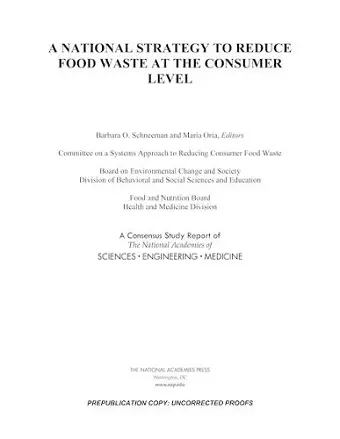A National Strategy to Reduce Food Waste at the Consumer Level
Division of Behavioral and Social Sciences and Education author Food and Nutrition Board author Board on Environmental Change and Society author National Academies of Sciences, Engineering, and Medicine author Health and Medicine Division author Committee on a Systems Approach to Reducing Consumer Food Waste author Maria Oria editor Barbara O Schneeman editor
Format:Paperback
Publisher:National Academies Press
Published:14th Nov '20
Currently unavailable, and unfortunately no date known when it will be back

Approximately 30 percent of the edible food produced in the United States is wasted and a significant portion of this waste occurs at the consumer level. Despite food's essential role as a source of nutrients and energy and its emotional and cultural importance, U.S. consumers waste an estimated average of 1 pound of food per person per day at home and in places where they buy and consume food away from home. Many factors contribute to this waste—consumers behaviors are shaped not only by individual and interpersonal factors but also by influences within the food system, such as policies, food marketing and the media. Some food waste is unavoidable, and there is substantial variation in how food waste and its impacts are defined and measured. But there is no doubt that the consequences of food waste are severe: the wasting of food is costly to consumers, depletes natural resources, and degrades the environment. In addition, at a time when the COVID-19 pandemic has severely strained the U.S. economy and sharply increased food insecurity, it is predicted that food waste will worsen in the short term because of both supply chain disruptions and the closures of food businesses that affect the way people eat and the types of food they can afford.
A National Strategy to Reduce Food Waste at the Consumer Level identifies strategies for changing consumer behavior, considering interactions and feedbacks within the food system. It explores the reasons food is wasted in the United States, including the characteristics of the complex systems through which food is produced, marketed, and sold, as well as the many other interconnected influences on consumers' conscious and unconscious choices about purchasing, preparing, consuming, storing, and discarding food. This report presents a strategy for addressing the challenge of reducing food waste at the consumer level from a holistic, systems perspective.
Table of Contents- Front Matter
- Summary
- 1 Introduction
- 2 Understanding Food Waste, Consumers, and the U.S. Food Environment
- 3 Drivers of Food Waste at the Consumer Level and Implications for Intervention Design
- 4 Interventions to Reduce Food Waste at the Consumer Level
- 5 Strategy for Reducing Food Waste at the Consumer Level
- 6 A Research Agenda for Improving Interventions to Reduce Food Waste and Their Implementation
- Appendix A: Public Session Agendas
- Appendix B: Literature Search Approach
- Appendix C: Additional Information...
ISBN: 9780309680738
Dimensions: unknown
Weight: unknown
322 pages